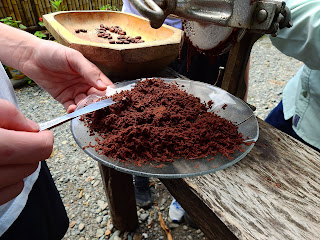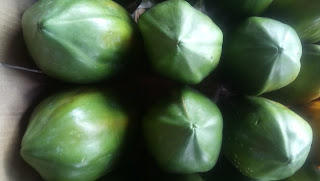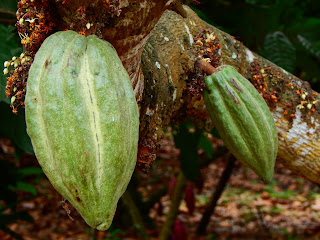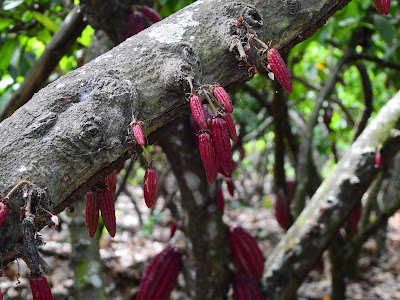Finally we reached the trip to a cocoa farm.
And it is not only vaos a UNA cocoa farm, among our suppliers we have three cocoa farms.
One more interesting and pretty than the other.
We will always adjust the visit to the interests of the group.
But we are not going to talk about suppliers now.
Let's take a walk to a cocoa farm together.
 The trip will always be a trip through the countryside. South-east of Guayaquil. South-west of Guayaquil or west of Guayaquil.
The trip will always be a trip through the countryside. South-east of Guayaquil. South-west of Guayaquil or west of Guayaquil.http://www.guayaquilaguidedvisit.com/book-online/#id=guayaquil-s-city-tour-plus-cacao-farm-guayaquil

And it will always include a very attractive and panoramic trip of approximately 45 minutes during which we will savor fruits, admire the landscape, and the existing fauna. As well as learn about the various eco-systems that surround the city of Guayaquil.
But , let talk about chocolate now.
and more specifically CACAO.
Theobroma cacao L. is the scientific name given to the cacao
tree or cacao tree, a perennial plant of the Malvaceae family.
Theobroma means, in Greek, "food of the gods".
Recent studies show that cocoa originated 5000 years ago in
the Upper Amazon. The theory indicates that this wild species was transported
in prehispanic times by the ancient settlers to Mesoamerica, where apparently
it is domesticated to be used in rituals.
The word cocoa has a
millenarian origin, and it goes back to the languages of the Mixe-Zoque
family spoken by the ancient Olmecs, who were the first to cultivate this plant
in Mesoamerica. In Maya Yucateco, "Kaj" means bitter and
"Kab" means juice. Alternatively, some linguists propose the theory
that with the passage of time he went through several phonetic transformations
that gave way to the word "cacaoatl", which later became
"cacao".
The ancient Mexican colonists considered it a divine tree.
The word cocoa (originally pronounced kakawa) seems to be related to the
Mixe-Zoque language and refers basically to the name of the plant.
http://www.guayaquilaguidedvisit.com/book-online/


http://www.guayaquilaguidedvisit.com/book-online/#id=guayaquil-s-city-tour-plus-cacao-farm-guayaquil


The accepted
varieties are:
Theobroma cacao f. pentagonum (Bernoulli)
&
Theobroma cacao subsp. sphaerocarpum (A.Chev.)Fresh Sun-dried & roasted cocoa beans
Parts of
cocoa
The main usefulness of the cocoa fruit is the production of
cocoa powder and fat or cocoa butter, both of which are used mainly for the
production of chocolate. Two thirds of cocoa produced worldwide is used to make
this product.19
Cacao products are extracted as cocoa powder that is dry and
dark brown in color, has the characteristic taste of cocoa. It is bitter and
free of impurities, strange smells or tastes. Besides being used in the
production of chocolate, it is used to flavor cookies, cakes, drinks and a
variety of desserts.
Also extracted is cocoa butter, known as theobroma oil, it
is the edible natural fat of cocoa bean, extracted during the process of making
chocolate and cocoa powder. It is used by the pharmaceutical industry for the
production of medicines; by the cosmetics industry for the manufacture of
beauty products (skin cleansers, masks, etc.), as well as for the production of
soaps.
Beverages can be made from the cocoa pulp, some with
alcohol. Finally, the peel of the fruit that is used to make infusions and even
used for animal feed, with its juice can be made jams.
Cocoa seeds with which chocolate is made.
The cocoa has a rough crust almost 4 cm thick. It is filled with a viscous, sweet and edible pink pulp, which contains thirty to fifty long grains (white and fleshy) arranged in rows in the lattice formed by that pulp. The grains or beans of the cocoa have the shape of the beans: two parts and a germ surrounded by a wrap rich in tannin. Its raw taste is very sweet and kind of citric.
In Ecuador, cocoa harvesting takes place throughout the year, every two weeks . In other parts of the world, West Africa for example, the main crop is harvested between September and February.
Guided by the color of the pod and the sound that makes its interior when slightly hit, the collector knows when the time of harvest has come. As soon as the pods mature, the so-called tumbadores, with a sickle or with a special sickle-knife fixed on a pole, cut the cob stalk, taking care not to damage the flowers and nearby buds. The fruit is then cut with the machete in the transverse direction.
The pods are cut without damaging the seeds. These are removed with a spoon-shaped utensil with the pulp that surrounds them, and are arranged in a sack. This starts the fermentation process, which lasts between three and seven days depending on the taste they want.
Biological process: fermentation
The bacteria and yeasts present in the air multiply in the pulp that surrounds the grains due to their concentration of sugars and this decomposes forming an acid liquid and alcohol. This increases the temperature of the pile and some transformations take place inside each grain. Its color changes from purple to chocolate brown and the smell of cocoa begins to manifest itself.
Fermentation is sometimes omitted, with planters and manufacturers in favor and against it. The objective of this fermentation is twofold: first, the pulp generates acetic acid that evaporates and the seed swells, until it resembles a thick brown almond. Second, bitterness and astringency are reduced, and aroma precursors develop. The quality of the grains depends on this fermentation process. If it is excessive, cocoa can be ruined; if it is insufficient, you can acquire a taste of raw potatoes and are attacked by fungi.
 Grinding cacao beans and producing our own chocolate paste
Grinding cacao beans and producing our own chocolate paste
Next, the grains are spread and, while they are constantly
raked, they are dried. In large plantations, this is done with huge trays, both
outside for the sun to act, and in sheds using artificial heat. The weight of the
grains diminishes with this process a quarter of its original weight.
Roasting, peeling, defatting
Cocoa follows a roasting process that refines aromas more
and reduces its astringency and bitter taste. It is separated from the husk and
so the beans (almonds or beans) are ready to be shredded (the nibs). By
grinding a paste called liquor or cocoa paste with about 55% shortening is
obtained. By pressing on the presses, a large part of the cocoa butter is
extracted, the fat fraction that will later be used to make the chocolate.
Thus, the fraction that remains after the cocoa butter is separated is the
cocoa cake, which retains a residual proportion of butter, usually between 10
and 20%, depending on the uses to which each cocoa is to be destined. By grinding,
the cake gives rise to lean or defatted cocoa powder.
OUR EXPERIENCE AT A CACAO FARM CONTINUES WITH LUNCH.
Because the ecuadorian gastronomy is beyond compare, we cannot think about this visit without LUNCH.
And what better than a nap after lunch?
 Banana plants
Banana plants


























































